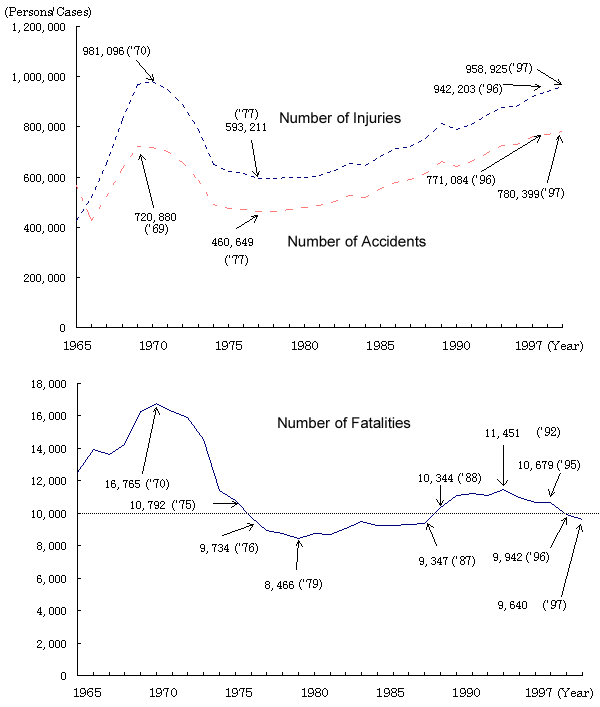
I. Road Traffic Accidents in Recent Years
Through 1970, the number of traffic accident victims in Japan rose each year as private motor vehicle use became more widespread. In that year, the worst on record, traffic accidents led to 16,765 fatalities and 981,096 injuries.
Recognizing traffic safety to be a pressing social issue requiring concerted action at the national level, the government created, under the Traffic Safety Policies Law, a series of five-year Fundamental Traffic Safety Program beginning in 1971. The vigorous and comprehensive promotion of various traffic safety measures under this program, including the establishment of additional traffic safety facilities, held the number of traffic accident fatalities to 8,466 in 1979 and to 8,760 in 1980, nearly satisfying the objectives of the first and second five-year plans.
Subsequently, however, the number of traffic accident fatalities began a rise which, although gradual, took it above 9,000 for 1982 and then above 10,000 for 1988, placing the objectives of the third, fourth and fifth five-year programs out of reach.
The Sixth Fundamental Traffic Safety Program (FY1996-FY2000) aggressively promotes comprehensive traffic safety measures that fully address traffic accident realities and aims to hold yearly traffic accident fatalities below 10,000 by 1997 and below 9,000 by 2000. However, with yearly traffic accident fatalities having fallen below 10,000 in 1997 for the second straight year, the first stage objectives of the Sixth Fundamental Traffic Safety Program have already been met (Fig.1).
A look at traffic accident fatalities per 100,000 population shows a peak in 1970 at 16.2, followed by a decline beginning in 1970 that reached 7.3 in 1979. A gradual rise followed and the number shifted between 8.0 and 10.0 starting in 1988. In 1997, however, the figure was 7.6, marking the second straight year below 8.0. The fatality rates per 10,000 motor vehicles and per 100 million vehicle-kilometers traveled fell steadily until the late 1970s and have continued on a slight downward trend since (Fig. 2).
Figure 1 Changes in Traffic Accidents and Casualties

Notes:
Figure 2 Changes in Traffic Accident Fatalities per 100,000 Population, per 10,000 Motor Vehicles and per 100 Million Vehicle-Kilometers Traveled
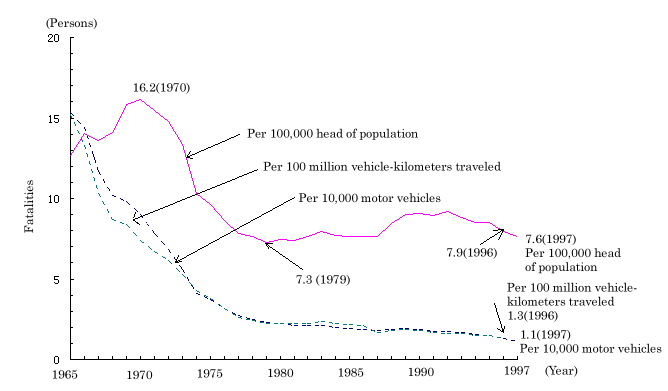
Notes:
II. Road Traffic Accidents in 1997
In 1997 there were 780,399 traffic accidents (limited here and below to those involving casualties) causing 9,640 fatalities and 958,925 injuries. Although the number of fatalities was 302 fewer than in 1996 and under 10,000 for the second straight year, the situation is still a serious one, with a record number of accidents for the fifth year in a row and more than 900,000 injuries for the third straight year.
2. Prominent Aspects of Traffic Fatalities
Compared to the previous year, traffic accident fatalities for 1997 declined for all road user types except pedal cyclists, with especially marked declines for pedestrians, young motorcycle riders and passengers and motor vehicle occupants. This may be attributed to traffic safety measures such as increased use of seat belts, improved road conditions, better driver education and safer vehicles.
(1) Fatalities by Age Group
Many of those killed in traffic accidents in 1997 were young people aged 16 to 24 (2,026) and senior citizens aged 65 and over (3,152). Together, these two age groups accounted for 53.7% of all traffic fatalities (Fig. 3).
(2) Fatalities by Road User Type
The road user type with the greatest number of traffic fatalities in 1997 was motor vehicle occupants, accounting for 44.1% of the total. Compared to the previous year, fatalities declined for all road user types except pedal cyclists, where there was an increase of 13, while there was a particularly large drop of 151 for pedestrians (Fig. 4).
Figure 3 Changes in Traffic Accident Fatalities by Age Group
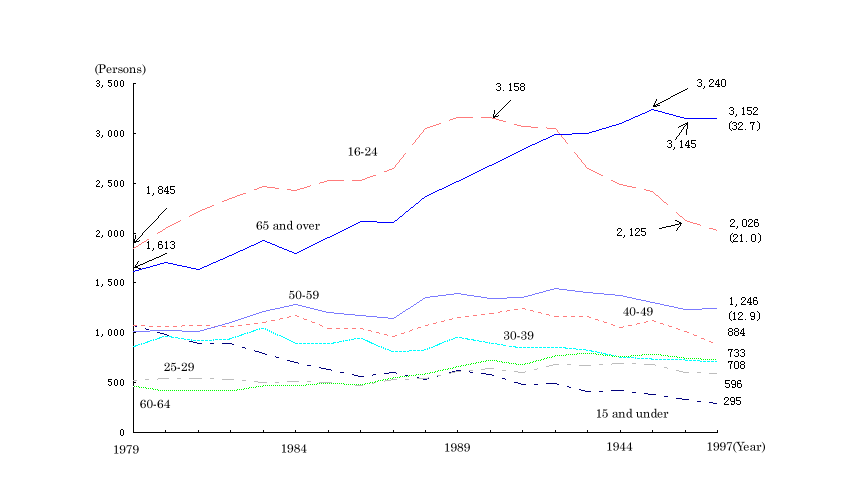
Notes:
Figure 4 Changes in Traffic Accident Fatalities by Road User Type
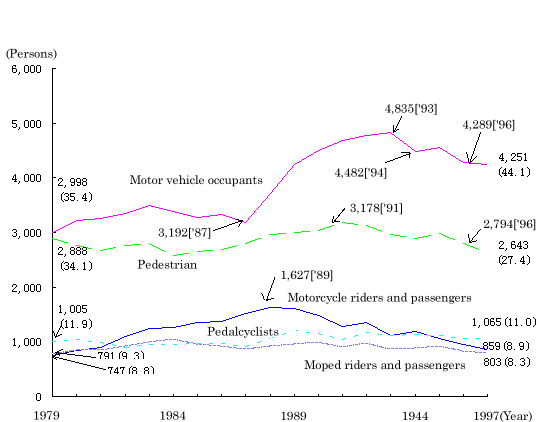
Notes:
(3) Fatalities by Road User Type and Age Group
The following features emerge when 1997 traffic fatalities by road user type are viewed by age group:
Figure 5 Changes in Fatalities Involving Young People by Road User Type
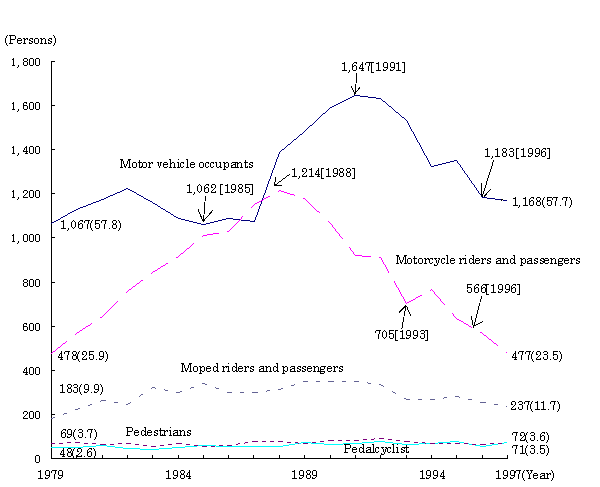
Notes:
Figure 6 Changes in Fatalities Involving Senior Citizens by Road User Type
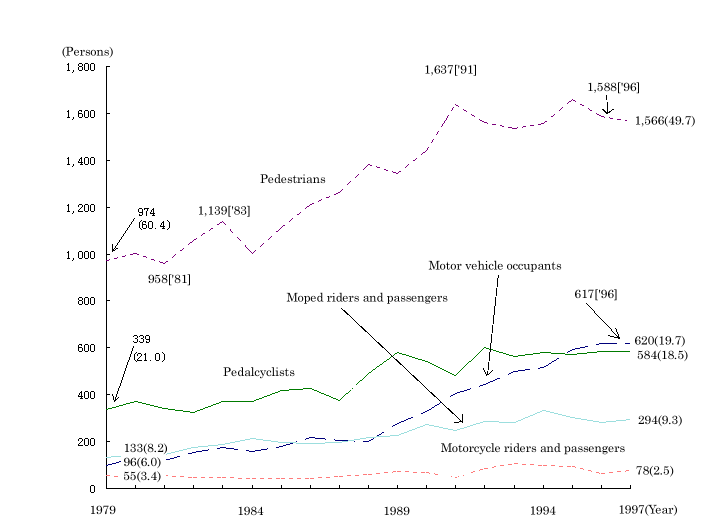
Notes:
(4) Fatalities and Seat Belt Use
Of the motor vehicle occupants killed in traffic accidents, 2,696 were not wearing seat belts, a drop of 303 compared to the previous year. Young people aged 16 to 24 accounted for 31.5% of these fatalities, 74 fewer persons than the previous year. In November 1986, seat belt use became mandatory for motor vehicle occupants in front seats on ordinary roads. Surveys of seat belt use frequency show that, although long unchanged, seat belt use has been on the rise since 1994 (Figs. 7 and 8).
Figure 7 Changes in Fatalities Involving Motor Vehicle Occupants by Seat Belt Use
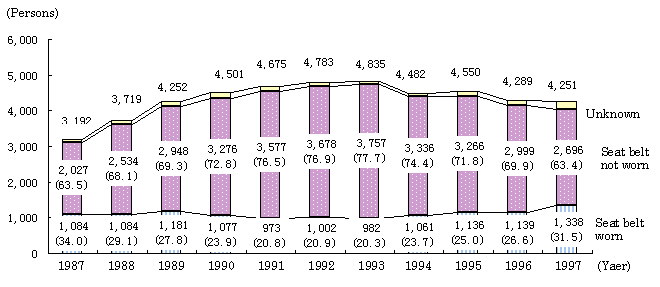
Notes:
Figure 8 Changes in Seat Belt Use
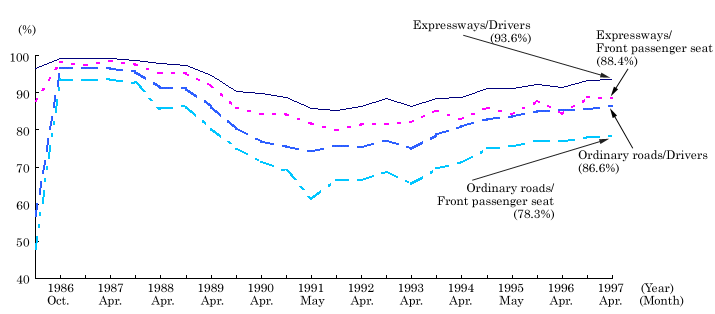
Source: National Police Agency
Young people in Japan today have grown up at a time in which the use of private motor vehicles is widespread and permeates the home; motor vehicles are now an extraordinarily familiar part of our young people's daily lives. A look at recent trends in driver's license acquisition shows that most people obtain their licenses in the early part of their lives. In other words, there are a large number of young people entering Japan's traffic society as new drivers every year.
The number of traffic fatalities for young people aged 16 to 24 is second only to that for senior citizens aged 65 and over, and they have the highest number of traffic injuries: significantly higher than for any other age group. Further, the number of cases where young people are the primary party in an accident is higher than any other group for both traffic accident fatalities and traffic accidents, indicating the extent to which young people are involved not only as victims, but as contributors.
Therefore, reducing the number of traffic accidents involving young people should lead to a reduction in the number of accident casualties not only among the young but all across Japan's traffic society. Furthermore, with a declining birth rate and an aging society expected to reduce the working-age population in the future, and with traffic accidents now the leading cause of death for young people, the reduction of traffic fatalities among the young is an issue with broad social implications.
1. Traffic Accidents Involving Young People
(1) Young People and the Traffic Society
Over the past few years, most young people have been obtaining a driver's license by their early twenties, with the percentage of those holding licenses at around 30% for 16 to 19 year-olds and about 83% for 20 to 24 year-olds.
An opinion survey conducted by the Management and Coordination Agency in 1994 indicated that 20% of senior high school students hoped to obtain moped licenses, while another 20% hoped to obtain motorcycle licenses. At the same time, more than 80% hoped to obtain standard driver's licenses and, of these, more than 80% hoped to do so before age 20.
Meanwhile, traffic accidents are the leading cause of death among young people (followed by suicide).
(2) Traffic Accidents Involving Young People
Traffic fatalities for 16 to 24 year-olds, while on the decline, nonetheless reached 2,026 in 1997, second only to senior citizens and 21.0% of the total. Traffic injuries involving young people, while steady for some years, still reached 244,230 in 1997, 25.5% of the total and significantly higher than any other age group.
Broken down by road user type, motor vehicle occupants accounted for more traffic fatalities than any other road user type in 1997, with 1,168 (57.7%). But for those aged 16 to 19, fatalities for motorcycle and moped riders and passengers accounted for 47.4% of the total, higher than for motor vehicle occupants (44.3%). For those aged 20 to 24, on the other hand, fatalities for motor vehicle occupants (68.6%) far exceeded those for motorcycles and mopeds (25.3%). Broken down by gender, males represented the vast majority of traffic fatalities with 1,652 (81.5%).
Accidents where a young person was the primary party accounted for just under 30% of traffic fatal accidents and traffic accidents, standing out as number one among all age groups and indicating the growing role that young people play as contributors to accidents (Figs. 9 and 10).
Figure 9 Changes in Accident Rates by Age Group (Primary Parties)
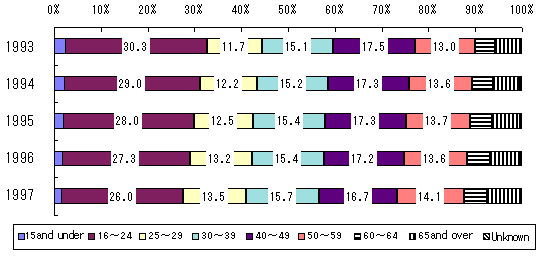
Source: National Police Agency
Figure 10 Changes in Fatal Accidents by Age Group (Primary Parties)
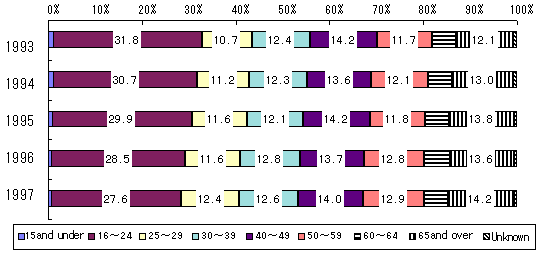
Source: National Police Agency
Looking at the number of fatal accidents per 10,000 licensed drivers for accidents where a motor vehicle, motorcycle or moped was the primary party, young people have by far the highest rate with 2.6 per 10,000, more than twice the rate of 1.2 for all age groups.
Fatal accidents where young people are the primary parties show the following major characteristics:
(1) Compared to all age groups, the proportion of single-vehicle accidents is high, while that for vehicle/pedestrian accidents is low (Fig. 11).
Figure 11 Percentage of Fatal Accidents by Accident Type (Primary Parties) 1997
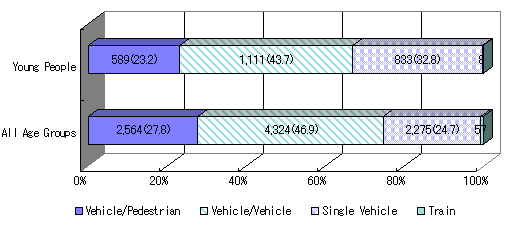
Notes:
(2) Compared to all age groups, a higher proportion of accidents occur on Saturday and Sunday (Fig. 12).
Figure 12 Percentage of Fatal Accidents Involving Young People by Day of the Week (1997)

Source: National Police Agency
(3) A high proportion of accidents occur at night, particularly between midnight and early morning. This trend is clear for motor vehicles and motorcycles but, despite a slight increase between late afternoon and night-time, the difference between time periods for mopeds is insignificant (Fig. 13).
Figure 13 Fatal Accidents Involving Young People by Time of Day and by Primary Party (1997)
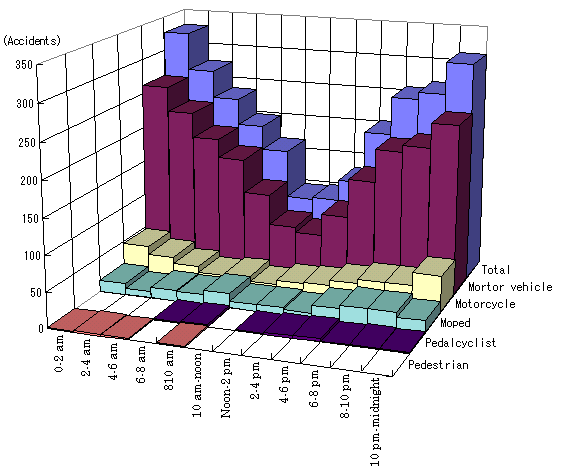
Source: National Police Agency
(4) A look at traffic violations for motor vehicles, motorcycles and mopeds shows that speeding is a much more common traffic violation for young people than for any other age group (Fig. 14).
Figure 14 Breakdown of Fatal Accidents by Traffic Violation for Motor Vehicles, Motorcycles and Mopeds (Primary Parties) by Age Group (1997)
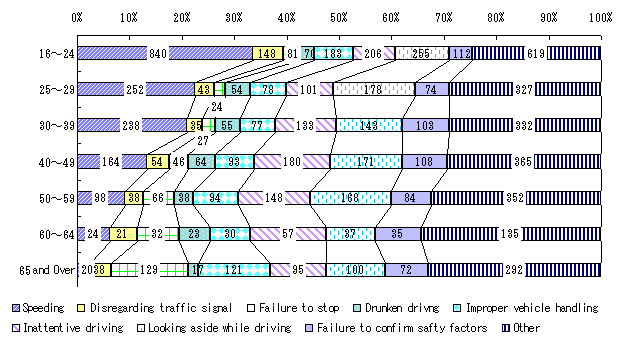
Source: National Police Agency
Based on the above, traffic accident fatalities among young people may be characterized as having fallen dramatically in recent years among motorcycle riders and passengers, and as occurring predominantly among males. Further, the young are often involved as contributors to fatal traffic accidents, and these tend to be single-vehicle, to occur at night, to occur on weekends, and to involve speeding.
2. Traffic Safety Measures for Young People
(1) Reinforcing Traffic Safety Education in Senior High School
In 1982, the Federation of All-Japan Senior High School Parent-Teachers' Associations launched its Three Don'ts Campaign (Don't get a license, Don't ride, Don't buy). However, in 1989 Traffic Safety Policy Head Office established its Comprehensive Measures for the Prevention of Two-Wheeled Motor Vehicle Accidents, which were designed to aggressively promote traffic safety education and guidance even at schools that were participating in the Three Don'ts Campaign. In 1997, the Federation of All-Japan Senior High School Parent-Teachers' Associations announced that it was expanding its Three Don'ts Campaign: that in addition to promoting the Three Don'ts it would also study how to effectively address two-wheeled motor vehicle safety issues while incorporating local conditions, and systematically conduct traffic safety training programs.
The Ministry of Education, Science, Sports and Culture has helped to strengthen two-wheeled motor vehicle traffic safety education at the Senior High School level by naming one Senior High School in each prefecture as a Designated Two-Wheeled Motor Vehicle Research School where practical research, including rider training, can be conducted.
(2) Promoting Traffic Safety Education for High School Age Group before License Acquisition
Young people of Senior High School age are not only old enough to obtain a two-wheeled motor vehicle license, they are also nearly old enough to obtain a standard driver's license; traffic safety education is extremely important for them. The Committee to Study Traffic Safety Education for Young People before License Acquisition, formed by the Management and Coordination Agency concluded that: 1 traffic safety education for them before they obtain licenses is just as necessary as that provided during and afterward; 2 since young people are likely to become drivers, traffic safety education should be designed to give young people the resources and attitude they will need to survive in a traffic society; and 3 schools, families and local authorities must cooperate closely in exchanging information and working together. Based on these conclusions, the Management and Coordination Agency is implementing model traffic safety education programs for young people who have not yet obtained a driver's license. Based on the results of these model programs, the Management and Coordination Agency will continue to study ways to develop and promote concrete and effective training methods, and work to further promote the expansion and diffusion of participatory, practical, hands-on learning.
(3) Reinforcing Traffic Safety Education at the Time of License Acquisition
Young people accounted for 88.0% of new license holders in 1997. Further, with 93.4% of new license holders (excluding moped, small-sized special and second class licenses) having graduated from a designated driving school, instruction provided at these schools forms the core of new driver education for the young.
The National Police Agency carries out thorough supervisory guidance of designated driving schools and is working to reinforce training systems. An amendment to the Road Traffic Law in 1994 introduced elements such as danger anticipation training, high-speed training and first aid training into the curriculum. In 1996, rider's training and skill evaluation programs for large-displacement motorcycles were introduced at designated driving schools, and there is an on-going effort to revise and strengthen training content through the introduction of such courses for both large-displacement and ordinary motorcycles.
(4) Reinforcing Traffic Safety Education after License Acquisition
Because newly licensed drivers, particularly the young, tend to cause many fatal accidents, a new-driver's period was established by an amendment to the Road Traffic Law in 1989 to raise awareness of safety issues among young drivers.
Additionally, members of the highly skilled elite motorcycle police units have been included as speakers at the safe driving lectures given when issuing two-wheeled motor vehicle licenses, largely to young riders.
In order to raise awareness of safe driving practices and to give drivers the discipline to follow them, the Management and Coordination Agency has implemented the Automobile Driver Safety Program as an effective driver re-education program for practical driving skills. Based on the results, they will continue to study ways to develop and promote concrete and effective training methods and work to further promote the expansion and diffusion of participatory, practical, hands-on learning. Furthermore, they are both conducting a national campaign for the prevention of two-wheeled motor vehicle accidents based on the Comprehensive Measures for the Prevention of Two-Wheeled Motor Vehicle Accidents and running two-wheeled motor vehicle accident prevention events aimed at young people.
(5) Promotion of Countermeasures against Hot-Rodders
Because many fatal accidents involving young people are caused by reckless driving, aggressive steps are being taken to effectively control the most dangerous and flagrant offenders, with an important focus placed on hot-rodder gangs, which are composed almost entirely of young people.
Coordinated police efforts to step-up and strengthen enforcement are working to contain hot-rodding itself. Meanwhile, the Councils on Countermeasures against Hot-Rodders, composed of concerned groups and organizations in each prefecture, are the focus of local efforts to promote various anti-gang activities such as trying to break up gangs, using individual counseling to convince gang members to leave and getting Junior and Senior High Schools to work with Police to counsel young people not to join gangs.
(6) Educational Activities to Promote Traffic Safety
In order to promote seat belt use, educational activities are being developed that allow people to experience the benefits of seat belt use, such as the demonstration lectures held at locations across the country using the Seat Belt Convincer.
Also, efforts such as using rider skill training courses to raise awareness of the importance of wearing a helmet are being promoted as a means of improving helmet use by two-wheeled motor vehicle riders, especially those on mopeds. In particular, promotional activities such as a national campaign to encourage the safe use of two-wheeled motor vehicles are being focused in the period around Motorcycle Day (August 19), when the Management and Coordination Agency also holds a Motorcycle Forum.
(7) Promotion of Vehicle Safety Measures
Based on findings at the Council for Transport Technology, standards for brakes were strengthened with the introduction of high-speed brake testing and fade resistance testing, as well as compulsory front and side impact testing for automobiles. Brake standards were also strengthened for two-wheeled motor vehicles with the introduction of high-speed brake testing and fade resistance testing, and an automatic system to turn the head lamp on with the engine was made compulsory in order to improve visibility.
Development continues on Advanced Safety Vehicle (ASV) with significantly higher levels of safety, and research and development is moving forward toward the production of a two-wheeled ASV with integrated systems by the early part of the 21st century.
Furthermore, in order to promote the spread of safer vehicles and raise awareness of safety issues among drivers, Automobile Safety Information are being published that list information such as vehicle's safety features and its performance in head-on collisions. (8) Improving the Road Traffic Environment
In addition to systematic improvements to expressways and other roads, efforts are also being promoted, based on the Seven-Year Specific Traffic Safety Facilities Improvement Program, that focus on ordinary roads, such as Community-Zone Creation Projects and Urgent Measures for Accident Black Spots. At locations conducive to reckless driving, effective traffic controls are being implemented and the installation of speed restriction systems and oncoming vehicle proximity warning systems is being promoted.
Additionally, two-stage stop lines at intersections, two-stage right turns for moped riders, and dedicated lanes for motorcycles are being introduced as traffic control measures to promote the smooth and safe operation of two-wheeled motor vehicles.
In accordance with the Sixth Fundamental Traffic Safety Program (FY1996-FY2000), particular emphasis was placed on promoting the following important policies:
(1) Concentration on Improving Traffic Safety Facilities
In FY1997, year 2 of the Seven-Year Program for Provision of Traffic Safety Facilities, the following projects were undertaken to improve the functionality of traffic control systems:
(2) Installation of Road Traffic Systems Using Advanced Telecommunications Systems
While promoting improvements directed toward the nationwide introduction of the Vehicle Information and Communication System (VICS), in accordance with the Basic Guidelines on the Promotion of an Advanced Information and Telecommunication Society formulated in 1996 by five Ministries and Agencies, trials were also conducted, under the Universal Traffic Management Systems (UTMS) project, of the Public Transportation Priority Systems (PTPS) and of non-stop Electronic Toll Collection (ETC) system.
(3) Promotion of Transportation Demand Management Measures
In looking for ways to address the increase in traffic volume, the New Congestion Mitigation Action Program (FY1993-FY1997) called for new ways of using the roads, such as park and ride, car pooling and flextime, and incorporated Transportation Demand Management (TDM) measures, which aim to improve transport efficiency and level out traffic demand across time and space. In a concrete implementation of these measures, 13 cities across Japan, acting as Cities Implementing Comprehensive Model Program to Mitigate Traffic Congestion, assist with trials aimed at introducing these measures and, by releasing and researching the trial results, contribute to the spread of TDM measures nationwide.
Further, in order to contribute to smooth traffic flow and quality-of-life in cities, the government is assisting several cities around the country to develop and implement Comprehensive Plans for Improving Metropolitan Traffic Flow that combine increasing traffic capacity with multi-modal and TDM measures.
The government is also promoting the Omnibus Town Project, which aims at safe and pleasant city planning centered around buses, which are easy on people, towns and the environment.
(4) Creating Traffic Safety Education Policy
As the result of an amendment to part of the Road Traffic Law, the Public Safety Commission was directed to formulate and disseminate policy for appropriate and effective implementation of traffic safety education, and to make efforts to conduct such traffic safety education for the public.
(5) Promotion of Traffic Safety Education for Senior Citizens
In order to raise awareness of traffic safety issues among senior citizens, the government is implementing a Project to Promote Safe Driving Practices among Senior Citizens as a form of participatory, practical, hands-on learning.
(6) Reinforcing Measures for Senior Citizen Drivers
As the result of an amendment to part of the Road Traffic Law, drivers over the age of 75 who wish to renew their license must attend a senior citizen driving course that includes actual driving and driving aptitude tests. Moreover, cars are now forbidden to cut in or encroach upon an automobile that displays the marker indicating an over-75 driver.
(7) Reinforcing Seat Belt Use
To ensure the use of seat belts and child restraints, an aggressive public information campaign was conducted using promotional activities and all forms of public media, in addition to the implementation of effective strategies to promote seat belt use based on the Selective Traffic Enforcement Program (STEP) method combining education, public relations and enforcement programs.
Additionally, a press release was issued that highlighted how the use of child restraints has reduced the number of accident injuries to child passengers.
(8) Educating the Public on the Use of Mobile Telephones while Driving
Based on research into the circumstances surrounding traffic accidents caused by using mobile telephones while driving, the Rules of the Road were amended to prohibit the use of mobile telephones while driving and to require them to be switched off before driving.
The Committee for the Improvement of Mobile Telephone User's Manners was established and mobile telephone companies across the nation launched a campaign to educate the public in mobile telephone etiquette, taking out joint advertisements in national newspapers and distributing manner handbooks.
(9) Implementation of a Comprehensive Traffic Safety Inspection
Traffic safety is achieved by reaching harmony between people, roads and vehicles. Since the issue requires the perspective of users, the government established the Comprehensive Traffic Safety Inspection in order to build a better traffic environment through the participation of local people and other road users.
(10) Development Assistance for Advanced Safety Vehicle (ASV)
The government promoted research and development of the ASV, primarily through a study group for promotion of ASV.
As a result of the comprehensive implementation of safety measures, including the promotion of measures against level crossing accidents, the installation and upgrading of operational safety equipment, improvements to control equipment and higher crew standards, the long decline in numbers of railway and level crossing accidents has continued. In 1997 there were 974 railway accidents resulting in 336 fatalities (Fig. 15).
By type, 493 (50.6%) of the accidents involved level crossing damage, 381 (39.1%) involved human casualties, and 67 (6.9%) involved road damage.
Figure 15 Changes in Railway Accidents and Casualties
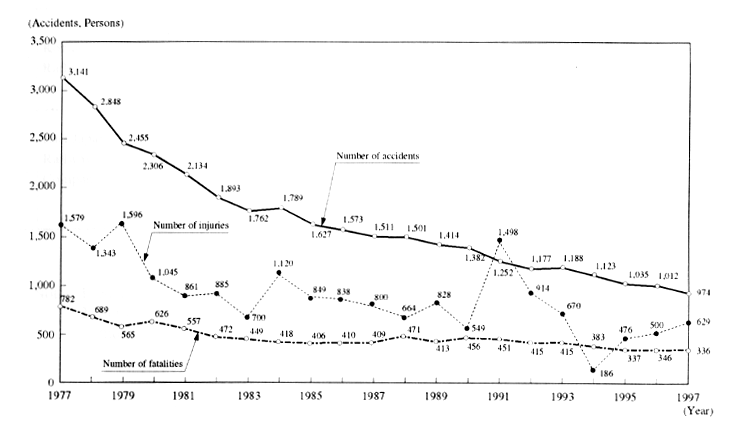
Source: Ministry of Transport
1. Serious Accidents
Serious accidents (those that involve 10 or more casualties, or the derailment of 10 or more cars) have declined by 45.7% in the past five years relative to the previous five years, but several such accidents still occur each year.
During the past 10 years, 54 serious accidents have occurred. Of these, 50.0% were train derailments, 22.2% were train collisions, and 20.4% involved level crossing damage.
In 1997, there were 7 serious accidents, with a higher than average proportion of train collisions. Train collisions resulting in multiple injuries occurred in August on Central Japan Railway Company's Tokaido Line and on Konan Railway's Konan Line, and in October on East Japan Railway Company's Chuo Line (Table 1).
Table 1 Overview of Serious Accidents (1997)
| Date | Operator | Line and Location | Type of Accident | No. of Injuries | No. of Derailed Cars | Main Cause and Details |
|---|---|---|---|---|---|---|
| Feb/1 | Kyushu Railway Company | Kyudai Line Bungomori Station | Derailment | 18 | 1 | A limited express collided with a dump truck which failed to stop at a Type 4 level crossing. |
| Apr/7 | Keihin Electric Rail-way Co., Ltd. | Keikyu Trunk Line Keikyu Taura - Anjinzuka | Derailment | 20 | 3 | A train was derailed by soil washed down a slope onto the tracks during rain. |
| Jun/28 | East Japan Railway Company | Tohoku Line Atago - Shinainuma | Derailment | 11 | 1 | A train was derailed by soil washed down a slope onto the tracks during rain caused by a typhoon. |
| Jun/28 | West Japan Railway Company | San-in Line Aseri - Tachiki | Derailment | 16 | 4 | A train was derailed where the track had been washed away during rain caused by a typhoon. |
| Aug/12 | Central Japan Railway Company | Tokaido Line Numazu Katahama | Collision | 43 | 3 | The driver failed to stop at a block signal, exceeding the speed limit and colliding with a freight train stopped ahead. |
| Aug/25 | Konan Railway | Konan Line Tateda Station | Collision | 41 | 0 | The driver failed to confirm the departure signal's stop display, resulting in a head-on collision with a train coming the other way. |
| Oct/12 | East Japan Railway Company | Chuo Line Otsuki Station | Collision | 78 | 7 | The driver failed to confirm the track change signal's stop display, and commenced changing track, colliding with the side of a limited express which was passing through the station. |
Notes:
2. Safety Measures to Prevent Serious Accidents
Since the three 1997 collisions occurred because responsible staff had failed to adhere to basic procedures, and could easily have resulted in much more damage, the Minister of Transport issued emergency directives to representatives of all the railway operators concerning the strict observance of basic operations by responsible staff. In response, a Railway Safety Liaison Meeting, formed of the Ministry of Transport and the Safety Division Directors from each of the JR companies, was convened to review each company's response to the Minister's directive and to work to strengthen guidance to prevent the re-occurrence of similar accidents. Railway operators that have not yet installed Automatic Train Stop (ATS) are being directed to do so.
The government is continuing to promote the implementation of integrated organization of track crossings, including over- or under-path track crossings, structural improvements, installation of track crossing safety equipment, and traffic control in accordance with the Crossing Track Improvement Law and the Sixth Comprehensive Crossing Accident Prevention Measures.
At the same time, the government is also stepping up public information campaigns to raise awareness of safety issues among motorists and pedestrians.
Further, while promoting improvements to track facilities and signal safety equipment, the government is also encouraging the thorough training of crew and staff to ensure their understanding of basic operations, strict adherence to duty, reliable operating procedures and appropriate operational control. It is also undertaking the necessary steps to direct the installation and upgrading of ATS and Centralized Train Control (CTC) and the installation of fire safety equipment in trains and facilities.
The Railway Safety Liaison Meeting is a forum where information about accident prevention may be exchanged, evaluated, and applied to the prevention of similar accidents in the future.
To improve the earthquake resistance of existing railway facilities and equipment, reinforcement works to increase earthquake resistance and to prevent bridge collapse are being carried out on the bridge girders and abutments and the central columns in cut and cover tunnels on Shinkansen (bullet train) lines and on heavy traffic sectors.